Best known for their supposed ability to predict spring weather and giving Bill Murray Déjà vu, the groundhog is one of the most notorious garden pests in the Eastern US.
These large rodents may look adorable and have a generally laid-back demeanor, but they’ll devour your entire garden before you know it.
You may be wondering if this critter is the one hanging out in your backyard and more importantly, how to get rid of groundhogs once you know they’re there. Read on to learn if this rodent has moved onto your property and how to get him back off of it.
Identifying Groundhogs
These big creatures are actually close relatives of squirrels, despite their size. They can be very shy and are rarely aggressive unless cornered. Because they are one of 14 different marmot species, it can be easy to confuse them with other common pests.
These critters live 3-4 years in the wild and have an average life expectancy of 6-8 years (14 year old groundhogs have been documented in captivity) and rarely stray more than 150 feet from their burrow, making a resident groundhog a long-term tenant.
What Do Groundhogs Look Like?
Picture a giant squirrel with a short tail and you’ll have a good starting image. In fact, they are a part of the squirrel family and have the ability to both climb and swim.
Their two coats of fur are shades of brown and sometimes grey, with occasional instances of albinos or nearly black fur. Their feet are covered in dark brown or black fur and are good digging tools.
A somewhat unusual quality among rodents, groundhog incisors don’t protrude when their mouths are closed and tend to be whitish instead of the common brownish-yellow of most rodent teeth.
On average, groundhogs measure 1 to 2.5 feet long and weigh 7 to 13 pounds, although they can potentially grow to be 24 inches (3 feet) long and weigh as much as 30 pounds when in an area with few predators.
Habitat
Groundhogs generally prefer wooded or grassy areas. They’re burrowing creatures, and a burrow will generally include multiple escape routes.
As a general rule, they’re solitary animals, although females bear litters of four to six pups (sometimes called chucklings) between March and April and will raise them for approximately three months before they depart to make their own burrows.
Groundhog Burrows
Groundhogs really are fascinating and intelligent creatures that keep a tidy home. A new burrow can be created literally overnight and is surprisingly large. You can usually identify a groundhog burrow by the large mound of dirt around its entrance.
To create the main entrance, a groundhog will burrow down at an angle approximately five feet, then back up two feet. This helps prevent flooding. The burrow proper is constructed here and consists of a 30-foot tunnel, a couple escape tunnels, and two side chambers.
The bedchamber is lined with grass, which is replaced with fresh grass during the spring if young are expected. The other chamber serves as an indoor bathroom. When the toilet has been filled, the groundhog seals up the entrance and digs a new bathroom chamber.
Burrows are an important part of mating, as males gain an overwhelming urge to mate after hibernation. They seek out other burrows and cautiously enter a female’s home if the scents suggest she is single, hoping she’ll invite him to the bedchamber for some quality time.
Hibernation and Groundhog Day
Groundhogs are one of the few species that sleep through the entire winter. Throughout summer, they feast in an effort to build up a nice layer of fat.
The first heavy frost marks bedtime, and the groundhog curls up into a ball in its bedchamber and slows its breathing and heart rate.
Studies show that the heartbeat can slow from 100 beats per minute to only four, while the body temperature may drop as much as 50 degrees.
One of the biggest attractions to groundhogs is their national holiday on February 2nd. This holiday is based upon the myth that groundhogs can predict an early spring if they emerge from their burrow and don’t see a shadow.
In reality, however, latitude has a major impact on hibernation times, and many groundhogs will sleep right through their holiday into early March.
What Do Groundhogs Eat?
Groundhogs (like prairie dogs) are primarily herbivores and prefer to eat berries, grass, red clover, ruffage, and bark. They have a reputation for eating vegetables and other crops which make them a nuisance in the garden.
However, they are also known to eat a lot of other garden pests, including caterpillars, roaches, grubs, grasshoppers, and snails.
What Does a Groundhog Sound Like?
Groundhogs communicate through a wide range of sounds, as well as through scent glands. Sounds include barking, chattering, growling, hissing, and shrieking. Some audio examples of groundhog sounds can be found at Hoghaven.
Other Names for Groundhogs
Depending upon where you live, groundhogs might be known by several different names. The most common nickname is the woodchuck, which many people mistakenly think refers to a different animal. Other common nicknames include land beaver and whistle pig.
Groundhog vs Beaver
Juvenile beavers are often mistaken for a groundhog at a distance, due to a very similar appearance. However, beavers aren’t part of the squirrel family and exhibit a lot of telltale signs that help with identification.
The wider tail and much larger size of beavers are signs that aid in identifying adults, and while groundhogs can be seen during the day, beavers are most often spotted at night.
If you can get close enough or view their tracks, the hind feet of beavers are webbed, while the groundhog has individual toes. Beavers also tend to live closer to water, as they build their homes on the surface to help deter predators from entering. Groundhogs, meanwhile, build their homes underground.
One telltale sign is their food source. Groundhogs eat leafy plants, fruits, and vegetables but also sometimes eat insects. Beavers, meanwhile, will gnaw on trees and wooden surfaces (which may include your deck or lawn furniture!) and leave behind tooth marks.
Groundhog vs Gopher
The term gopher has often been applied to ground squirrels and other non-gopher species, making it a little difficult to do a proper comparison. However, the 36 species of pocket (or true) gopher all share some specific traits that set them apart from groundhogs.
Groundhogs grow to be several feet long, while the gopher’s body remains a similar size to squirrels (excluding their tails). Also, gopher fur will always blend into the same color as the soil where it lives. You will also see active gophers during the winter months.
Finally, groundhogs graze while gophers hoard their food using cheek pouches to transport food to their smaller dens.
Groundhog vs Woodchuck
As noted above, groundhogs and woodchucks are the same animal. Some regions of the country may use one name over the other. The real reason why groundhogs are called woodchucks is more complicated.
Why You Don’t Want Them Around
Burrows and Structural Damage
Groundhogs are notorious for creating extensive burrow systems. These burrows can pose a significant threat to your property. As they dig their tunnels underground, they can weaken the foundation of structures such as sheds or even your home.
In addition, their burrows can be hazardous for people and your pets, causing accidents like twisted ankles or potential falls.
Keep an eye out for any holes in your yard or around your property, as this may be a sign of groundhog activity. You’ll want to address these burrows as soon as possible to minimize the risk of structural damage or injury to you and your pets.
Read Also: Getting Rid of Porcupines
Destruction of Gardens
These critters are not just an annoyance due to their burrowing habits, but groundhogs can wreak havoc on your gardens as well. These rodents love to munch on your vegetables and fruits, causing significant damage to your carefully cultivated plants.
As you tend to your garden, watch for signs of groundhog activity, such as:
- Bites or chew marks on vegetables and fruits
- Digging or evidence of burrows near the garden
- Uneven ground, collapses, or sinkholes around planting beds
Getting Rid of Groundhogs
There are a lot of methods for getting rid of groundhogs and woodchucks, but some are a lot more effective than you might expect. Here are some of the most popular ways to evict a groundhog from your property (and keep them out).
Relocation
One of the best ways to get rid of groundhogs is to find them another place to live. Remember that a groundhog can excavate a new den overnight and lives a solitary lifestyle, so don’t feel bad about transporting the little guy somewhere else.
There are different live traps available, but most follow the same rules for use.
Note: Be sure to check up on local and state regulations first to see whether you are allowed to catch a groundhog yourself or must call to have wildlife officials perform the task.How to Trap a Groundhog
What you will need:
- Bait (cantaloupe works best, but you can use other garden plants the groundhog likes)
- Bricks or heavy stones
- Heavy gloves
- Live trap (our favorite)
- Materials for camouflage
Covering the trap in mud can be a good way to begin the camo process. Place the trap up against the den entrance and stick your bait in as far back as possible to ensure the groundhog is fully inside.
Placing some bricks or heavy stones on top will help prevent the groundhog from knocking the trap over. Next, prime the trap and cover it with sticks, leaves, and other debris.
Be sure to check the trap often, and be ready to transport your captive critter as soon as possible so he doesn’t injure himself. Wear the heavy gloves and make sure you keep the trap away from your body to avoid being bitten or clawed.
The relocation point should be a good five miles away, and you will want to stay clear of the trap door when you open it, in case the critter decides to share its opinion of you.
Why We’re Against Killing Groundhogs
While there are ways to kill a groundhog, we strongly urge against it – and not just because of the slow, horrific suffering these methods cause. Using poisons or shooting a groundhog might seem a viable option, but an injured groundhog is a dangerous one. Instead of being shy, they will become highly aggressive.
Another reason to avoid poison and kill traps is the fact that either can prove fatal to other critters, including children and pets. Any poison that works on a groundhog will be equally effective against your family.
A roaming cat or dog can easily get caught by snare traps and other lethal types of trap. Why put your loved ones at risk when you can get rid of groundhogs safely?
However, fumigation via gas cartridges that release carbon monoxide do have their place in certain situations.
No products found.
Groundhog Deterrents
Sometimes the best offense is a good defense, and this is especially true when dealing with critters. A good deterrent will not only keep groundhogs from setting up camp in your backyard, they can also help evict a resident critter.
Ammonia and Cat Litter
Groundhogs won’t stay where they sense a lot of predators. Sprinkling used cat litter or rags soaked in ammonia will help trick the critter into thinking it’s a dangerous spot. As ammonia can harm your lawn, you will want to place the rags on something to keep it separated from the grass.
As this method is essentially free for cat owners, it is litter-ally one of the best tricks to for getting rid of groundhogs and other big critters.
Epsom Salts
One of the most useful bathroom supplies can also help fend off hungry critters. Epsom salts are safe to ingest (they have been a popular diuretic for centuries), and groundhogs hate the taste.
Simply sprinkle some on your plants and the groundhog will take his business to a different restaurant. Keep in mind, the salts will wash off when it rains, so you will need to reapply them occasionally.
Will Mothballs Get Rid of Groundhogs?
The answer to this one is a little complicated. First, it’s worth noting that mothballs are intended to be used only in airtight containers inside your home. Outdoor use of mothballs is technically illegal in the United States according to the EPA. In addition, if you have small kids or pets, you simply should not be using mothballs anywhere where they could get to them.
That said, mothballs can help to get groundhogs out of your yard, but it won’t stop them from returning. When you find a burrow entrance on your property, you can push a few mothballs into the entrance. This will prevent the groundhog from using that entrance for several weeks while the smell dissipates.
Unfortunately, simply filling in the hole or throwing more mothballs in occasionally doesn’t keep a groundhog from slipping back into your yard through the fence or from another burrow opening.
Getting rid of groundhogs with mothballs can be a useful stopgap method if you’re in the process of installing a more groundhog-proof fence in the garden, but should never be considered your first strategy or a full solution.
Automatic Sprinklers
There are electronic sprinklers on the market which are motion activated, such as the popular Orbit Yard Enforcer. Stick these in your garden and other key spots. When the groundhog gets too close, the sprinkler activates and scares them off. As an added bonus, it waters your plants for you.
Fencing
In your duel against groundhogs, a good weapon is chicken wire. Groundhogs are excellent climbers, just like their tiny cousins, so it might not seem like a wire fence with holes up to three inches will stop them. However, the trick is to bend the fencing into a six foot tall “C” shape.
Place two feet of it underground, with the horizontal part facing out. This keeps the woodchuck from getting under the fence. Meanwhile, the outward-facing top part of the C will stop him from climbing over.
Repellent Plants
A good way to deter groundhogs is by planting repellent plants around your garden. These plants have strong smells or tastes that groundhogs don’t like, making your garden a less appealing place for them to visit. Some plants you may want to consider include:
- Sage
- Lavender
- Chives
- Thyme
- Rosemary
- Oregano
- Basil
- Mint
- Lemon Balm
Incorporate these plants into your garden design to create a natural barrier that keeps groundhogs away. Remember to place them strategically around the perimeter of your garden or near areas where groundhogs tend to visit.
Other Natural Repellents
- Cayenne Pepper – Mixing cayenne pepper with water and a little dish soap creates a potent spray that groundhogs dislike. Apply this mixture to your garden and the perimeter of your property to discourage groundhogs from coming near. Reapply after rainfall.
- Garlic – Crushing a few cloves of garlic and mixing them with water, dish soap, and a few drops of hot sauce creates an effective repellent. Spray this mixture on your plants to help keep groundhogs from feasting on them.
- Epsom Salts – Sprinkle Epsom salts near the entrances and exits of groundhog burrows, or around the perimeter of your garden. This natural product is harmless to groundhogs but will help drive them away.
- Castor Oil – Mix castor oil with water and apply it to areas where groundhogs frequent. This can help discourage them from visiting your yard or garden.
Ammonia-Based Repellent
You might have seen advertisements for commercial groundhog repellents. These are ammonia-based repellents are designed to mimic the scent of predator urine. Unfortunately, their effectiveness is sometimes less than perfect, and it’s usually best to stick to used litter, if the option is available.
Groundhog Health Risks
While groundhogs are generally shy and peaceful, they can attack if cornered or wounded. Groundhog bites can be very painful and should be cleaned and bandaged immediately. You should always seek medical attention as a follow-up to groundhog bites to avoid disease.
Lyme Disease
While gophers themselves don’t transmit this disease, they can carry ticks. Lyme disease has mild symptoms early on, but can develop into temporary paralysis and other neurological problems. Left untreated, it can cause arthritis, impaired memory, neuropathy, and even heart problems.
Rabies
These critters are known to be carriers of rabies and are more susceptible than other rodents. Obvious signs of rabies include foaming at the mouth, erratic behavior, and not being afraid to approach humans. However, a carrier may exhibit no symptoms at all, so be sure to get tested after any encounter.
Tularemia
This particularly nasty disease isn’t common, but groundhogs are known carriers. Depending upon how the disease comes into contact with your body, it can have different symptoms ranging from mild to life-threatening.
In addition to personal health, their burrows can destabilize buildings and cause property damage. They can also devour food crops and tear up gardens.
Groundhog Benefits
As with most critters, groundhogs actually have some benefit, if you can learn to live with them in peace. They are known to eat insects, including grubs and caterpillars, which are harmful to your garden. Their burrows can also help aerate the soil.
Speaking of burrows, groundhog burrows act like animal hotels, and the groundhog will often allow foxes, skunks, and other critters to share its residence. This might sound bad at first, but a critter with a home is far less likely to invade your’s.
- How to Get Rid of Hawks - March 8, 2024
- How to Get Rid of Pill Bugs (Rolly Pollies) - March 1, 2024
- How to Get Rid of Groundhogs (Woodchucks) - February 5, 2024

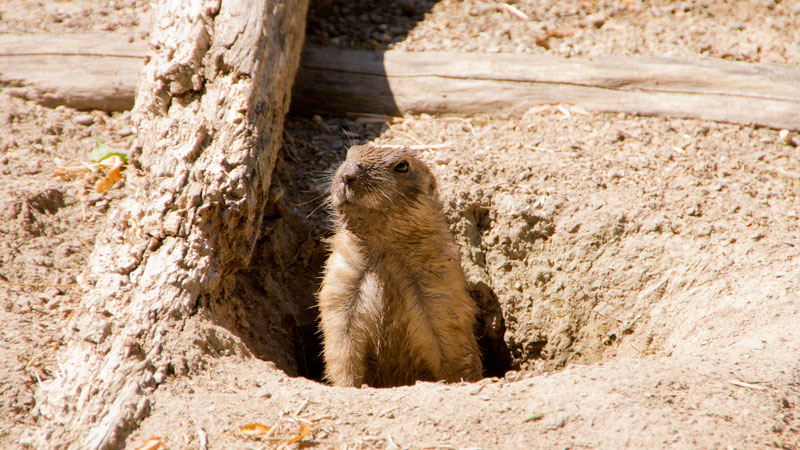

 Just tell me how to get rid of ’em.
Just tell me how to get rid of ’em.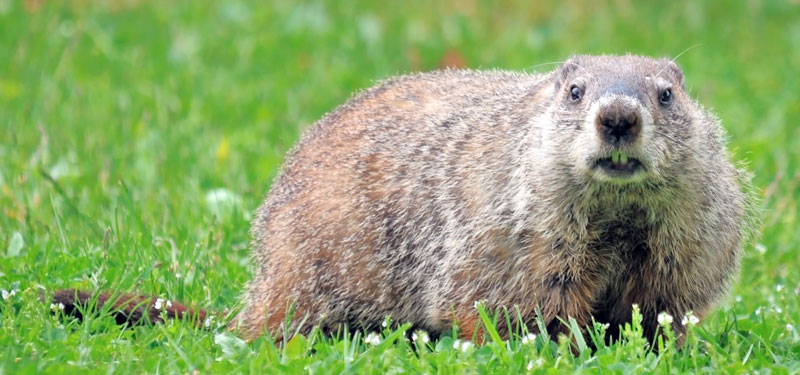
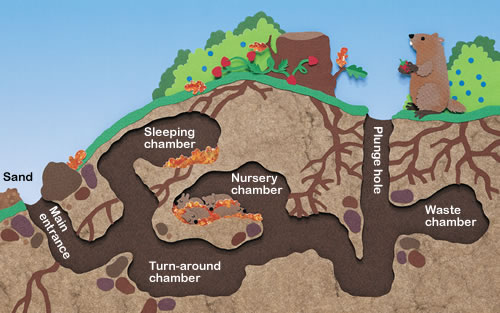
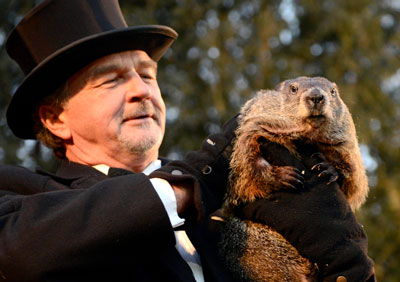
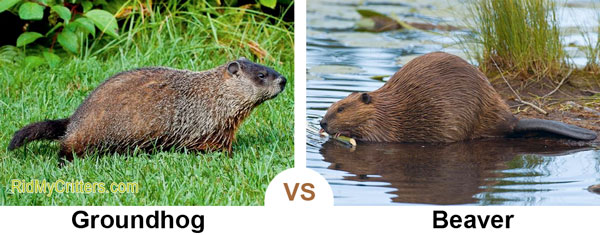
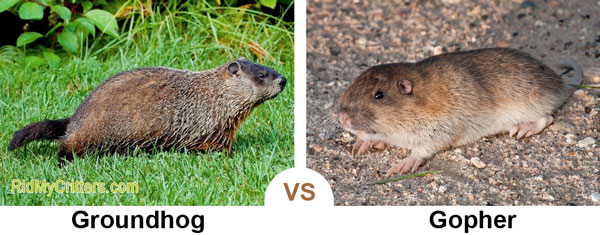
we have plastic down on a dirt floor in our basement we don’t kn if its a ground hog or raccoon but it tears up the plastic sometimes at night or in morn the area is only a crawl space and we cant get in there to find out we have went around the outside of the house and have found no holesbut we have a vacant house next door to us so we are at a lose
This sounds a lot like either rats or groundhogs. Both are known to make their home underneath vacant houses. Try setting some traps, and if that doesn’t work, you may need to find out who owns the vacant house and have them bring in an exterminator.
It is said in the BIBLE that man is to be over & control any 4 legged creature or animal. That’s in GENESIS so why save animals that are detsructive to your property & gardens & give them their HOME RIGHTS at your cost of their destruction/s ? Same goes for deer, bear & other 4 legged destructive animals, who damages property in other ways. My question is,, Do these options of deterences that you say that frustrate & make groundhogs go away, work for these other animals & different ones I did not mention ? Like a thief that comes at night or DAYTIME now,,who never tells what time they are going to steal from you, these rodents do not let you know when they are coming to your place either. You can’t kill anything right up by a concrete step & back door, as we had a 58 inch RATTLESNAKE that we did eliminate as the BIRDS warned us it was there again. The BIRDS were all flying LOW above the ground. Sure signs there is a snake somewhere near by. Of course you never kill a blacksnake which I saw one 6 foot long going up a maple tree last evening, but it never stays around to eat a groundhog or a rattlesnake.
Hello. I appreciate your perspective. I need t o get rid of 4 or 5 of the critters a they have destryed by neighbors and my own garden.
That’s the old Testament that gives man dominion over. Jesus came with a new message of love for all creatures in God’s world. Christianity evolved with the coming of Christ.
Wrong. The only thing that changed was Jesus’s blood covered all sins. There was no longer a need for animal sacrifice. If you think the old testament is no longer applicable, then you haven’t read what Jesus said in the new testament.
I have tried all the ways above to get rid of groundhogs under my house. No doubt they have another way in and when stuff wears off they are right back. I even trapped a second one and marked it before hauling it more than 10 miles to a wooded area. It came back!! I don’t know what else to try besides trapping and killing.
This B**** IS LEAVING MY YARD TONIGHT, ONE WAY OR THE OTHER.
Haha. That’s the spirit.
I have tried everything to get rid of these groundhogs the lives in my backyard my grandkids and there friends can’t play on the trampoline or swings or the pool because of these groundhogs I rented the traps and trapped one after 7 hours he got out I need help bad I can’t afford to hire no one I’m disabled scared to sit on my pouch these groundhogs are huge what do I suppose to do
Where do you live. Many hunters will shoot them for you if you live in the country. Or call the Department of natural resources in your state and ask them and tell them your disabled and can’t afford a hired gun.
Good luck.
hello,
I’m thinking that one humane way to kill a groundhog is to wait till it enters hibernation (which in S. Central Pa is now), block all entrance/exits and then send in the ammonia laden rags or one of the Gopher Gasser “Bombs.” Maybe they won’t know what hit ’em if they are asleep??
When I see a new burrow in my yard, I start up my lawnmower and park it over the burrow entrance for a minute or two. I’ve never had a groundhog return to that burrow afterwards.
How much Epson salt do you use?
Is there any way to determine where their burrow entrance is, based on their favorite eating spots perhaps? Or any other way? Their old entrance got blocked (neighbors threw in lots of empties, both cans & bottles, which haven’t been disturbed). My shed is large & off the ground, and they love it under there. But where is their burrow now? If I could find the entrance…
This is a great article but how do you get rid of a ground hog that is already in hibernation?
You can try flooding them out and hoping they leave your property but they’ll likely just setup another burrow. Fumigation is usually the best option here. Gas cartridges which produce carbon monoxide can be purchased at farm or garden supply stores.
Folks, this will work every time and will last for years because other hogs will use the same holes. Garlic in oil. They hate garlic. Get a jar at the grocery and pour in as far as you can down the hole. That’s it. I’ve got holes that I did this to 7 years ago and still no hogs have used it.
My groundhog just reappeared after a year, and I will use the garlic and ammonia method to deter them from digging up my yard.
Get yourself A have a heart trap. Place by its burrow with Either Cantelope apples carrots. You’ll catch him go to move them at least 5 miles more the better
Tried the trap, The first night I got an opossum. The groundhog was sitting at the entrance to his burrow like he was laughing at the opossum. I waited a couple of days and tried again. Groundhog watched me setting the trap. He ate all the cabbage leading up to the trap but did not go in. This time I got a skunk. He ate the cabbage in the trap. When I let him out, he went into the burrow, which he is sharing with the groundhog.